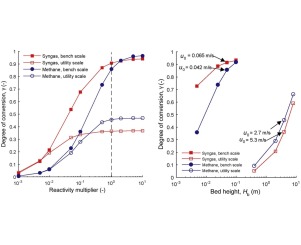Particuology ( IF 4.1 ) Pub Date : 2017-06-17 , DOI: 10.1016/j.partic.2017.02.007 Jesper Aronsson , David Pallarès , Anders Lyngfelt

|
This work investigates the scale-up of chemical looping combustion (CLC), a next-generation technology for carbon capture and storage, to the industrial scale. The study focused on the bottom bed of the unit, which was considered to be the critical region during scale-up due to the large solids inventory in this zone combined with relatively inefficient gas–solids contact. Two CLC reactors of vastly different sizes (bench and utility scale) were studied to discern their difference related to scale-up via a one-dimensional model. This model considered kinetics that varied with the degree of oxidation and population distribution of the oxygen carriers, the mixing of which accounts for both convective and dispersive transport. The model was validated against bench scale data, and was used to evaluate the performance of a 1000 MWth CLC fuel reactor using either syngas or methane as fuels. Sensitivity analyses were also carried out with this model to determine the effects of several parameters on fuel conversion, including solids circulation, oxygen carrier reactivity, bed height, and maximum bubble size. The results show that the mass transfer of gas from bubbles to the emulsion phase represents a significant limiting factor for fuel conversion in the bottom bed of a utility scale fuel reactor.
中文翻译:

化学循环燃烧系统中气态燃料反应堆的建模和规模分析
这项工作研究了化学循环燃烧(CLC)(一种用于碳捕获和存储的下一代技术)的规模扩大到工业规模。该研究集中在该装置的底部床层上,该床层被认为是扩大规模时的关键区域,这是因为该区域中的大量固体存量以及相对低效的气固接触。研究了两个尺寸(台式和实用规模)相差很大的CLC反应器,以通过一维模型识别它们与放大相关的差异。该模型考虑的动力学随氧气载体的氧化程度和总体分布而变化,氧气的混合说明了对流和分散输运。该模型已针对基准规模数据进行了验证,并用于评估1000 MW的性能个使用两种合成气或甲烷作为燃料CLC燃料反应器中。还使用此模型进行了敏感性分析,以确定几个参数对燃料转化的影响,包括固体循环,氧气载体反应性,床高和最大气泡尺寸。结果表明,气体从气泡到乳液相的传质代表了在实用规模燃料反应器底部床中燃料转化的重要限制因素。











































 京公网安备 11010802027423号
京公网安备 11010802027423号